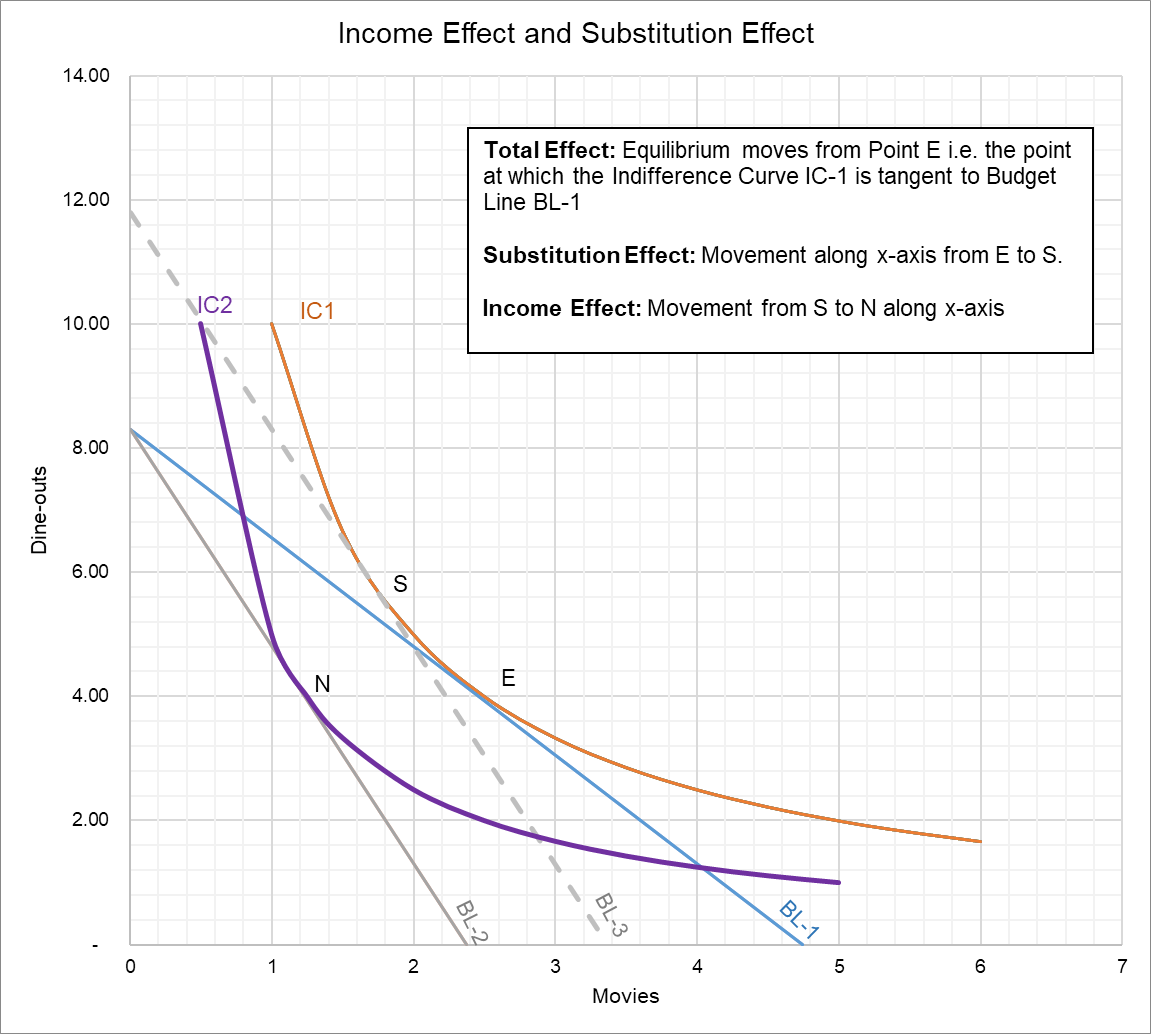Income Effect vs Substitution Effect
Income effect and substitution effect are the components of price effect (i.e. the decrease in quantity demanded due to increase in price of a product). Income effect arises because a price change changes a consumer’s real income and substitution effect occurs when consumers opt for the product's substitutes.
Let’s consider a consumer who has a monthly budget of $165 which he allocates between movies and dine-outs. A movie costs $35 and a dine-out costs $20. The maximum number of movies he can watch and the number of time he can dine-out are 8.3 ($165/$35) and 4.75 ($165/$20) respectively. This is represented by the consumer’s initial budget line BL-1 in the graph below:

The consumer’s initial budget line BL-1 is tangent to the indifference curve IC1 at point E. This is the consumer’s current equilibrium i.e. the combination of movies and dine-outs which the consumer is happy with in his budget of $165.
Now, let’s assume that a movie’s price doubles i.e. the new price is $70. The increase in price of a movie rotates the budget line from BL-1 to BL-2. In the total budget of $165, the number of dine-outs possible is the same because the dine-out price has not changed. However, the number of movies that can be watched effectively halves to 2.37 (=$165/70). The new budget line BL-2 is tangent to a lower indifference curve IC2 at Point N. This shows a drop in the consumer’s total utility due to an increase in price of movies.
The total decrease in quantity demanded of movies equal the difference between movies demanded at E and at N. It is because consumers switch to alternate goods (substitution effect) and because a price change reduces purchasing power of the consumer (i.e. income effect). In other words, the total price effect is a combination of income effect and substitution effect:
Price Effect = Substitution Effect + Income Effect
Substitution Effect
It follows from the law of demand that the quantity demanded of a product increases if the product price decreases and vice versa. One reason for this phenomenon is substitution i.e. when consumers discontinue consumption of the product whose price increases and switch over to other similar products. It happens when the increase in price renders the product more expensive than its substitutes and rational consumers decide that it is not worthwhile to continue consuming the product at its increased price.
To determine the magnitude of substitution effect, we ignore the income effect i.e. the rotation of the budget line. We do this by shifting the budget line outwards such that it intersects the initial indifference curve at Point S. The decrease in quantity demanded of movies that occurs due to movement along the initial indifference curve IC1 from Point E to S represent the substitution effect.
Please note that the substitution effect is at play in changing quantity demanded when all other determinants of demand i.e. price of substitute goods, income level, etc. are constant. The rotation of budget line the current example is due to imputed change in real income and not an actual change in income. When there is an actual change in income level, it shifts the demand curve i.e. it causes a change in demand at all price levels.
Income Effect
Substitution effect explains only half of the mechanism that results in downward-sloping demand curve. Another way in which a change in price results in change in quantity demanded is by resulting in a change in purchasing power of the consumer i.e. the income effect.
The income effect equals the difference between quantity demanded of movies at Point S and Point N. The income effect arises because at the increased price of movies, the consumer feels less rich.
Income and Substitution Effects: Normal Good vs Inferior Good
In case of a normal good i.e. a good whose quantity demanded increases with increase in income, the substitution effect and the income effect reinforce each other i.e. they work in the same direction. The example discussed above is a normal good and hence the substitution effect and income effect work in tandem.
In case of an inferior goods (also called Giffen good), the income effect and substitution effect work in opposite directions i.e. the net effect equal the difference between substitution effect and income effect. It is because an inferior good reacts differently to a change in income. Its demand increases with decrease in income and vice versa.
by Obaidullah Jan, ACA, CFA and last modified on